July's a busy month for skywatching. Not only are five bright planets in view, but three comets and a newly-discovered nova are also observable. And it all starts with a bang on Independence Day.

Bob King
Many of us will be watching the fireworks on July 4th. The fact that most of the elements in the materials used to make these colorful explosions originated in the violent and explosive deaths of massive stars proves the universe has a wicked sense of humor.
Think about it. The sulfur, oxygen, and carbon in the fuel, and the iron, strontium, barium, and copper that gives the sparks their gold, red, green, and blue colors, were created and set free when massive stars self-annihilated. What goes around comes around!
I have fond memories of fireworks as a kid and still enjoy the shows. On a clear 4th-of-July night with so many people out, it's a great time to introduce friends and family to the sky. There's often time before the big blast to look about during twilight and again later at night after arriving home. Everyone's awake and wired.
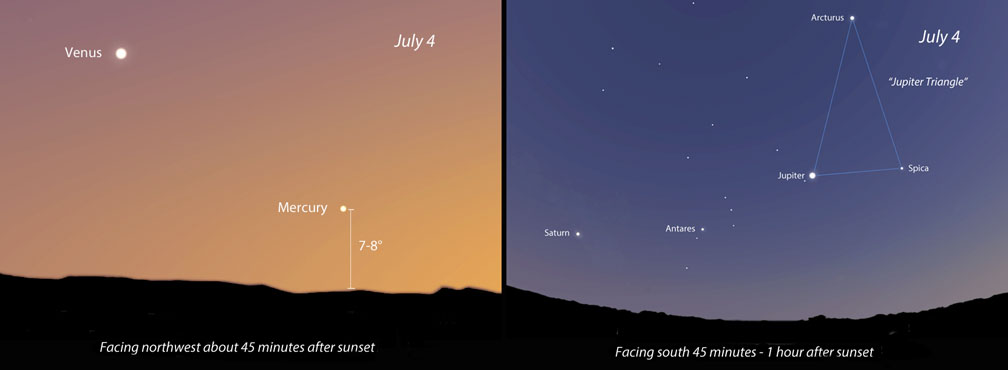
Stellarium
This season, there's much to see at dusk, including Venus and Mercury in the western sky and Jupiter and Saturn in the south. The Summer Triangle shines in the east with campfire-colored Arcturus twinkling high in the southwestern sky. Show the kids how to connect Jupiter, Arcturus, and Spica into the giant "Jupiter Triangle."
Don't forget Antares! Located not quite midway between Saturn and Jupiter, this red supergiant star is the summer version of winter's famous giant, Betelgeuse. Both are likely to explode as supernovae in the not-too-distant future, returning freshly forged elements to the interstellar medium that might be come in handy for another special occasion in a far off time.

NASA / Damian Peach
Once the kids are in bed, point a scope at the next planet in the parade, Mars. The recent planet-swallowing dust storm continues to transform the appearance of surface features on the Red Planet. The club of Sinus Meridiani, the Solis Lacus "eye", and even mighty Syrtis Major have been so altered they're nearly impossible to recognize. Only parts and pieces remain in view under expansive clouds of obscuring dust. Debris even covers much of the south polar cap, which otherwise would gleam snowy white.
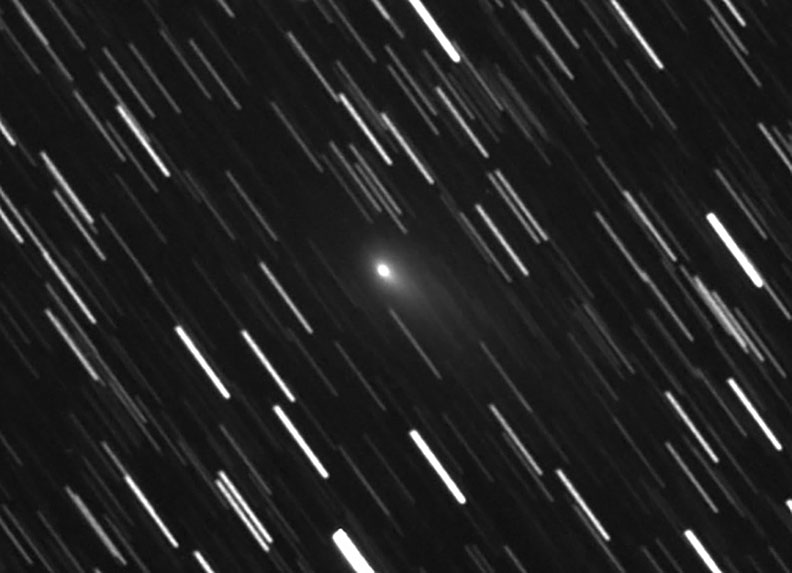
Alfons Diepvens
Turning from planets to deep-sky objects, amateurs can also get their first look at returning comet 21P/Giacobini-Zinner as it tracks north across Cygnus into Cepheus this month. Though still only magnitude 11-11.5, it's brightening rapidly and expected to reach magnitude 7 by late August. Am I wrong or does it feel like forever since we had a binocular comet? I found the little fuzzy on July 2.16 UT in my 15-inch reflector. With a magnification of 64× I saw a 1′-diameter, moderately condensed coma with a faint, star-like false nucleus and a 2′-long tail pointing southwest.
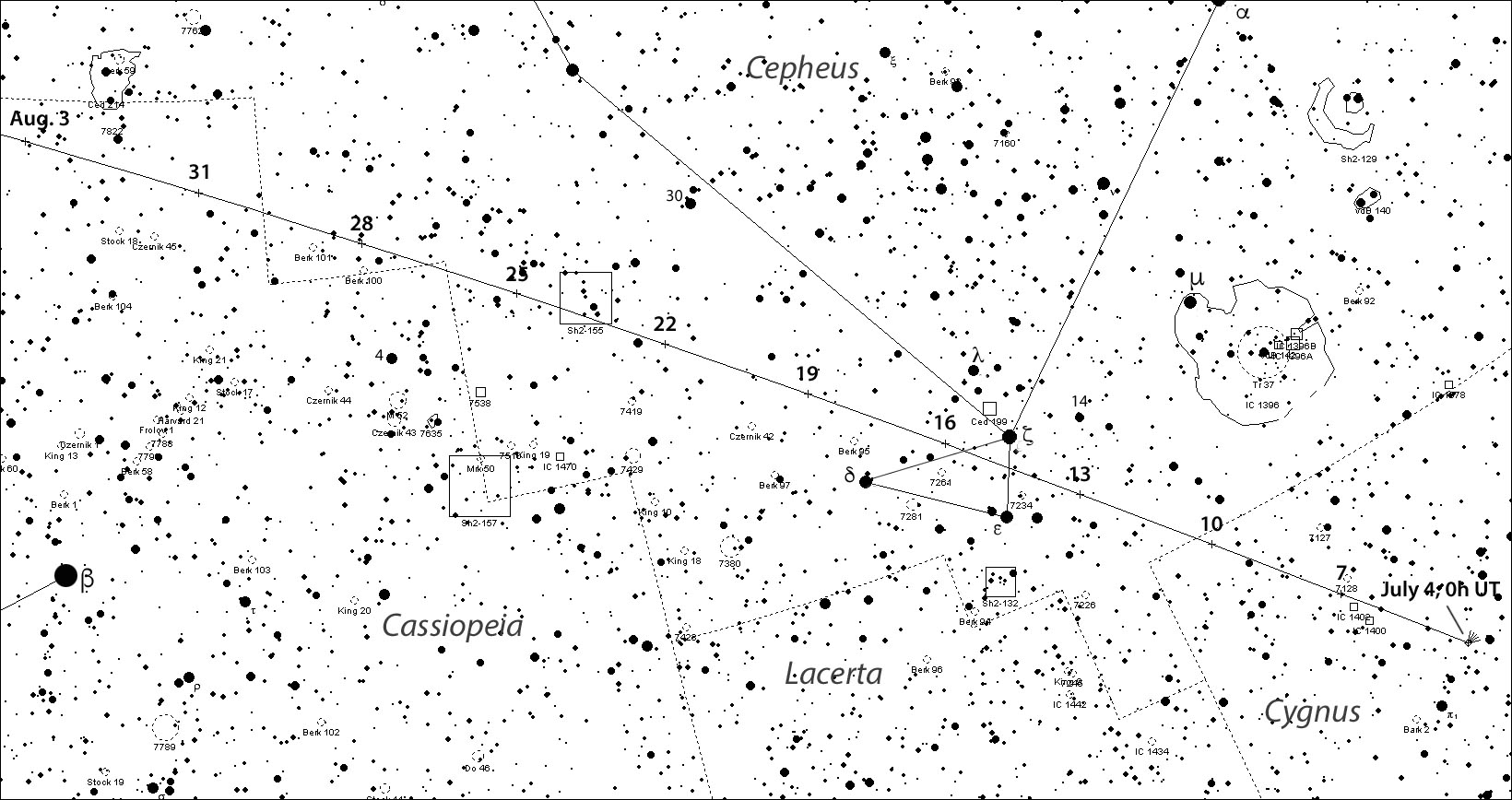
Chris Marriott's SkyMap with additions by the author
Discovered in 1900, 21P/G-Z became the first comet to be visited by a spacecraft. On September 11, 1985, NASA's International Sun-Earth Explorer 3 — renamed and repurposed as the International Cometary Explorer (ICE) — passed directly through its tail and gathered data on the comet's interaction with the solar wind. Perihelion occurs on September 10th, within a day of its closest approach to Earth (0.39 a.u. / 58.4 million km).
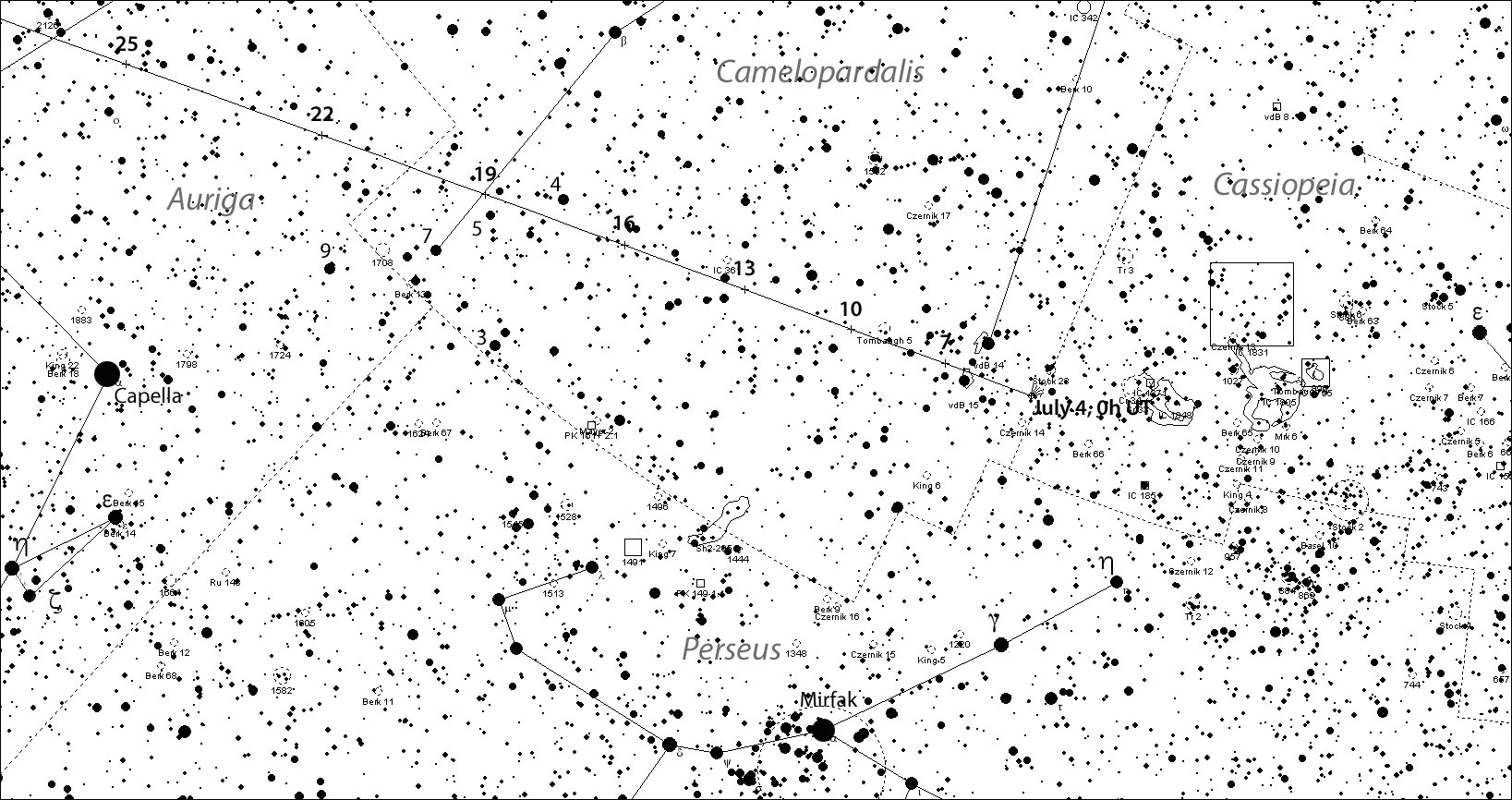
Chris Marriott with additions by the author
That's not all the comet news this month. Comet PanSTARRS (C/2017 S3), which had been chillin' at magnitude 12.5, experienced an outburst some time on June 30th, rocketing to magnitude ~9.5 overnight. Located in Camelopardalis northeast of the Double Cluster, it was super obvious in the 15-inch at low power on July 2.18 UT, appearing as a dense, tailless cotton ball about 3′ across. It looked suspiciously "gassy," so I applied the Swan Band filter and both the brightness and size of the coma increased, a sure sign of a gas blast from the outburst.
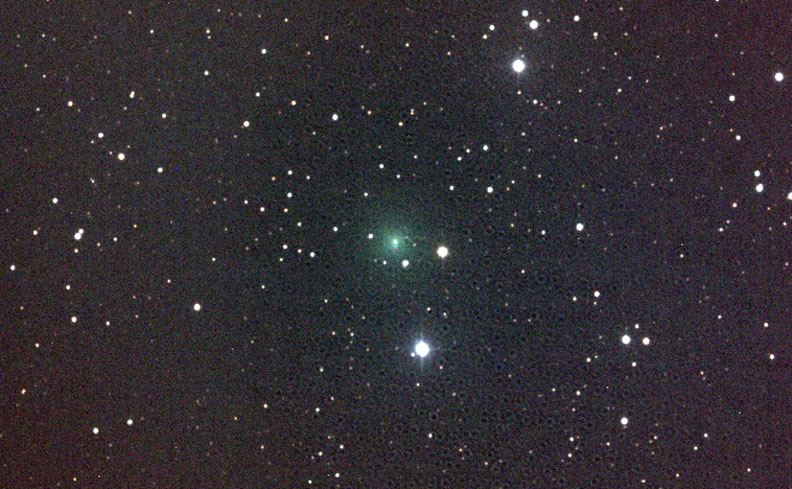
Michael Mattiazzo
Comet C/2017 S3 may reach magnitude 3 or 4 as it speeds sun-ward in the morning sky en route to an August 16th perihelion. Keep an eye on it with the included chart and expect the unexpected. The outburst could continue or even trigger the comet's disintegration. For more information and an additional map through August 11th, click here.
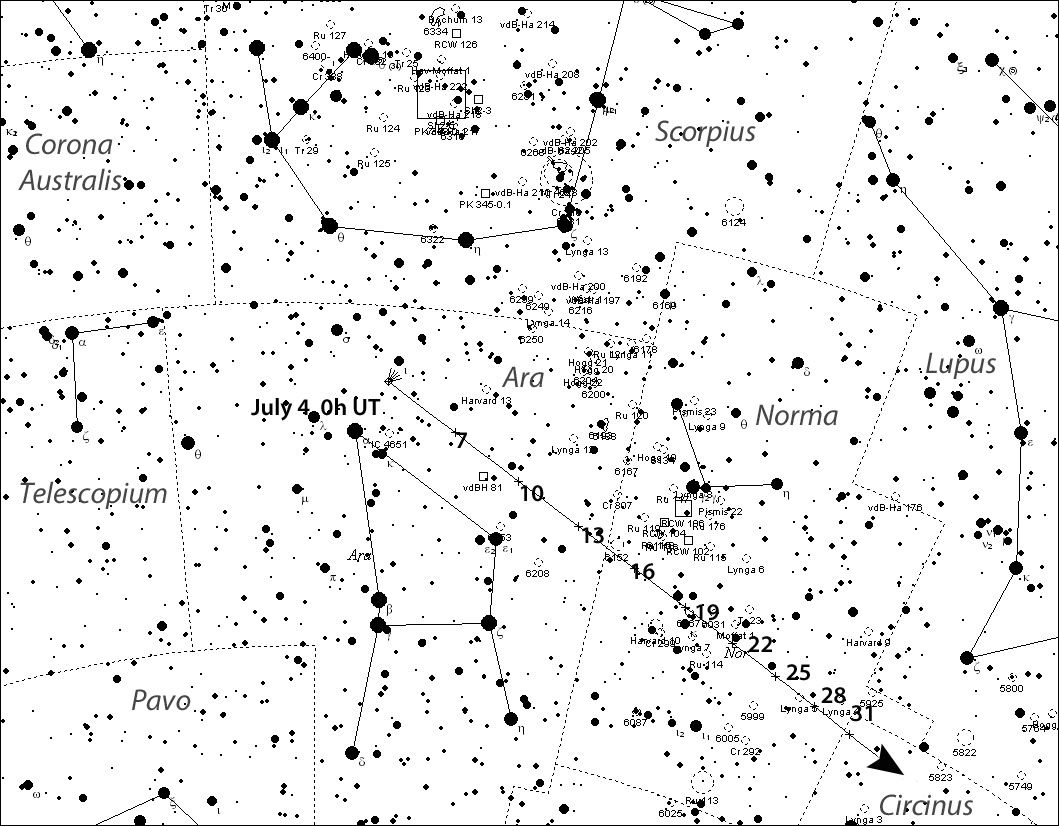
Chris Marriott's SkyMap with additions by the author
While observers in the southern U.S. and points south won't get a good look at that particular Comet PanSTARRS because of its northerly declination, they'll have their own PanSTARRS comet, C/2016 M1. It's currently at its brightest, a small, condensed ball glowing at magnitude 9 in the constellation Ara below the tail of Scorpius.
We end where we began — with an explosion. On June 29th, Yukio Sakurai of Japan discovered a new nova, shining in Scutum at magnitude 10.3. Although it's since faded a touch to ~11.0, this "guest star" is easy to find just a few arc minutes northeast of the 4.6-magnitude star Gamma (γ) Scuti. You can star-hop there from Saturn and then use this AAVSO chart to suss out the nova and estimate its brightness. A 6-inch telescope should suffice.
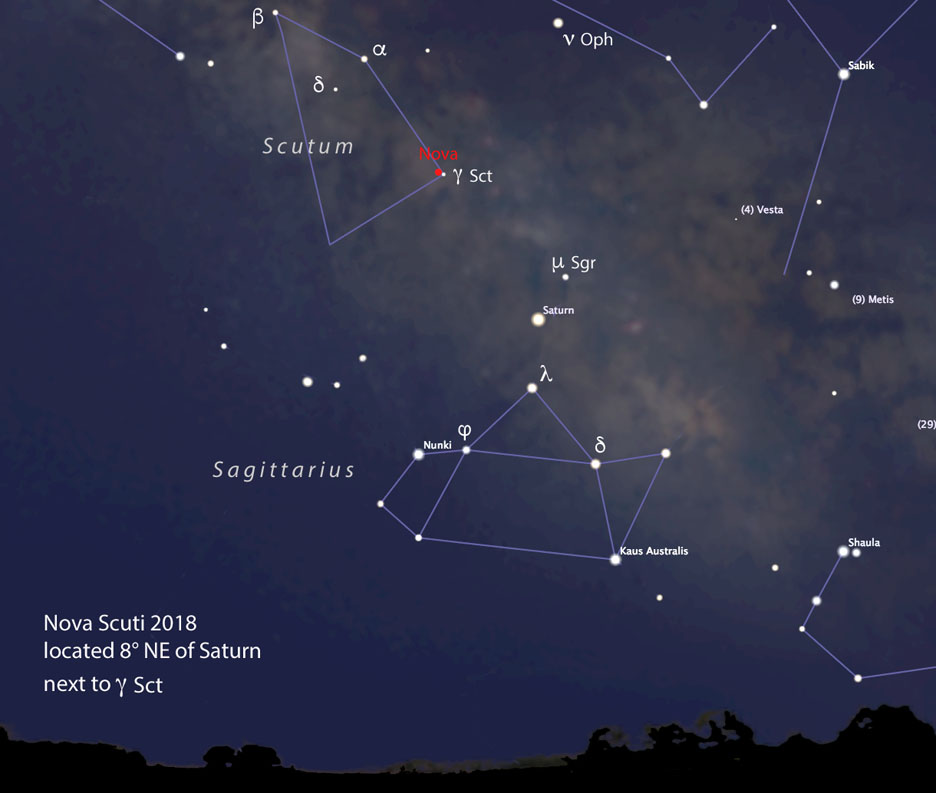
Stellarium
Novae occur in close binary stars where one of the members is a white dwarf. The dwarf siphons gas from the companion into a whirling accretion disk and ultimately down to its surface. There it's heated and compressed until burns in a runaway thermonuclear blast. Novae explosions can shine with a luminosity up to 100,000 times that of the Sun. Enough fireworks for anyone!
 8
8









Comments
Tom-Reiland
July 3, 2018 at 3:24 pm
Bob, I was able to observe Nova Scuti on Saturday and Sunday nights at Wagman Observatory. I made a rough estimate of 11 mag on both nights. Being that close to Gamma Scuti makes it very easy to spot. The AAVSO chart is a very good aid for locating it. It was nice to find so soon after it was discovered. Too bad it was not on the rise to a much brighter magnitude.
You must be logged in to post a comment.
Bob KingPost Author
July 3, 2018 at 5:23 pm
Hi Tom,
Glad you grabbed early views. I caught it between clouds last night at 11.3. It's about as easy as anything to find. A pity it's not on the rise as many more people would find and see it with ease.
You must be logged in to post a comment.
Anthony Barreiro
July 3, 2018 at 3:29 pm
Hi Bob. I don't even try to see small faint comets from the city. But last week we had a couple of very clear (although windy) nights here in San Francisco. And no planets are currently hidden behind the Sun. So I scored a solar system bingo two nights in a row! Between sunset and dawn I observed Mercury, Venus, Jupiter and the Galilean moons, Vesta, Saturn and Titan, Earth's Moon, Mars, Neptune, and Uranus, with naked eye, binoculars, and a small refractor. This was the first time I've seen Neptune and Uranus during their current apparitions, and it took a bit of work to find them the first morning, but the second time was easier.
You must be logged in to post a comment.
Bob KingPost Author
July 3, 2018 at 5:25 pm
Anthony,
Definitely a bingo - maybe two bingos. You deserve a solar system ambassador award!
You must be logged in to post a comment.
Anthony Barreiro
July 3, 2018 at 6:17 pm
I'm awaiting my ambassadorial credentials from the United Federation of Planets.
You must be logged in to post a comment.
Bob KingPost Author
July 4, 2018 at 11:21 am
Anthony,
Indeed! Hand-delivered by Capt. James T. Kirk.
You must be logged in to post a comment.
SNH
July 5, 2018 at 2:36 pm
First of all, I'm at 36.1 degrees North, and I last looked at comet M1 as it was on the border of Sagittarius and Corona Australis. I picked it up in my 8x56 binoculars and placed it at +9.5. Too bad its now heading deep south because it was a bright little dude!
Didn't know about the outburst of PanSTARRS (C/2017 S3), so will take a look in my binoculars! Nor did I know about the nova, so thanks for that. Looked at Mars last night (08UTC) and was sadly only able to see its North Polar Hood and South Pole Ice Cap in my 10-inch SCT since the rest is covered in dust! Darn!! It's so large and yet has so little detail visible!!!!
Great article, and nice fireworks image, Bob!
Scott
You must be logged in to post a comment.
Tom-Reiland
July 7, 2018 at 4:38 am
Bob, thanks to your charts I was able to locate Comet G-Z and PanSTARRS C/2017 S3. This was at least the 4th apparition that I've observed G-Z. It was fan-shaped and I estimated it at 9.5 mag. Comet PanSTARRS was round with a gradually brighter center. I put it at about 10 Mag. Nova Scuti has brightened to 11mag. Vesta is still easy to find and I observed all of the planets starting with Venus, Mercury, Jupiter and Saturn in the evening and finishing with Mars, Neptune (with Triton) and Uranus in the morning. I should be able to get a few more nights in a row with this fair weather disaster moving into Western Pa. It was a great way to celebrate 72 years on this planet as the clock reached Midnight.
You must be logged in to post a comment.
You must be logged in to post a comment.